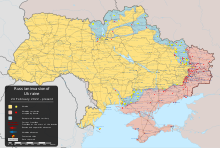Russo-Ukrainian War
This article is about a current event. |
| Russo–Ukrainian War | |||||||
|---|---|---|---|---|---|---|---|
 Map of the military situation | |||||||
| |||||||
| Belligerents | |||||||
|
Supported by:
|
Supported by: | ||||||
The Russo–Ukrainian War[2] is an ongoing conflict between Russia and Ukraine that began in February 2014. It started when Russia took over Crimea and funded anti-government rebels in the Donbas region. It escalated in February 2022 when Russia invaded the whole of Ukraine.
The number of soldiers that have been wounded or killed is a half million (as of 2023), according to U.S. authorities.[3]
History[change | change source]
War in Donbas[change | change source]
On 20 February 2014, Russian soldiers took control of Crimea. The Annexation of Crimea by the Russian Federation soon followed. Russia also supported separatists in the Donbas region, who took control of the Donetsk Oblast and the Luhansk Oblast and declared them as independent countries.
In August 2014, Ukraine attacked the separatist oblasts. A ceasefire, the Minsk Protocol, was agreed on but both sides continued fighting, with 85% of the ceasfire violations being done by Russia.[4] The fighting slowed down and became a frozen conflict.
Invasion of Ukraine[change | change source]
In 2021, more and more Russian soldiers and weapons arrived near the border with Ukraine. There was fear of a possible invasion.[5]
On 17 January 2022, Russian troops and weapons began arriving in Belarus for a 'military exercise', that [started or] was going to start in February; Its name is Allied Resolve.[6] The following month, Russia officially recognised the separatist regions in Donetsk and Luhansk as independent countries (separate from Ukraine). Russian soldiers then began appearing in the regions.
On 24 February 2022, President Vladimir Putin announced the invasion of Ukraine.[7] Most other countries declared their support for Ukraine, especially the countries of the NATO military alliance. Many other countries began sanctioning Russia (such as stopping trade, participation in events and the travel of Russian politicians) as a way to fight Russia without using soldiers.
Russia's effort to take Kyiv, the capital of Ukraine, failed in early April 2022 and had to withdraw. Ukraine began taking back land that Russia had taken over the course of 2022. In September 2022, four Russian-controlled separatist regions of Ukraine were annexed as member states of Russia.
In 2023 the frontlines changed very little, with many calling the war a stalemate. However, the year saw many important events, such as when the Wagner Group, a Russian mercenary company, took over the Russian city of Rostov-On-Don and tried to reach Moscow (capital of Russia), after it's leader had complained about how the war was going. On the 6th of December, US senators blocked aid money to Ukraine.[8]
Related pages[change | change source]
- List of ongoing armed conflicts
- 2022 Russian invasion of Ukraine
- The Long Breakup, a film about the relationship between Ukraine and Russia.
References[change | change source]
- ↑ https://genderdesk.wordpress.com/2023/05/23/belgorod-peoples-republic/
- ↑ Snyder, Timothy (2018). The Road to Unfreedom: Russia, Europe, America. New York: Tim Duggan Books. p. 197. ISBN 9780525574477.
Almost everyone lost the Russo-Ukrainian war: Russia, Ukraine, the EU, the United States. The only winner was China.
; Mulford, Joshua P. (2016). "Non-State Actors in the Russo-Ukrainian War". Connections. 15 (2): 89–107. doi:10.11610/Connections.15.2.07. ISSN 1812-1098. JSTOR 26326442.; Shevko, Demian; Khrul, Kristina (2017). "Why the Conflict Between Russia and Ukraine Is a Hybrid Aggression Against the West and Nothing Else". In Gutsul, Nazarii; Khrul, Kristina (eds.). Multicultural Societies and their Threats: Real, Hybrid and Media Wars in Eastern and South-Eastern Europe. Zürich: LIT Verlag Münster. p. 100. ISBN 9783643908254. - ↑ https://www.nettavisen.no/nyheter/i-atte-ar-kjempet-roman-43-mot-russerne-sa-gikk-det-nesten-forferdelig-galt/f/5-95-1294219. Nettavisen.no. Retrieved 2023-09-01
- ↑ Young, Cathy (2022-04-13). "What Really Happened in Ukraine in 2014—and Since Then". The Bulwark. Retrieved 2024-01-14.
- ↑ "Statement by Press Secretary Jen Psaki on President Biden's Call with President Volodymyr Zelensky of Ukraine". The White House. 2022-01-02. Retrieved 2022-01-03.
- ↑ "Russian forces arrive in Belarus for joint military drills". Reuters. 17 January 2022.
- ↑ "Russia attacks Ukraine". CNN. 24 February 2022. Archived from the original on 24 February 2022. Retrieved 24 February 2022.
- ↑ Greve, Joan E.; Wintour, Patrick (2023-12-06). "Senate Republicans block funding bill that included aid for Ukraine and Israel". The Guardian. ISSN 0261-3077. Retrieved 2023-12-20.

